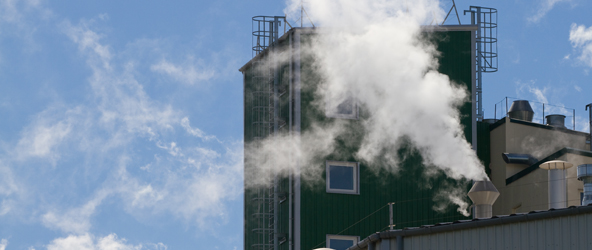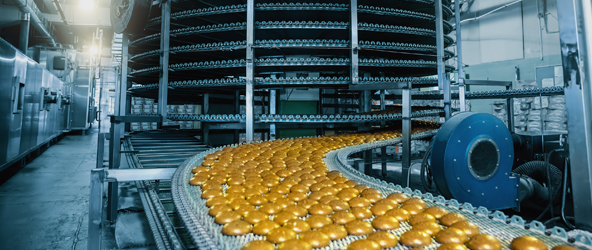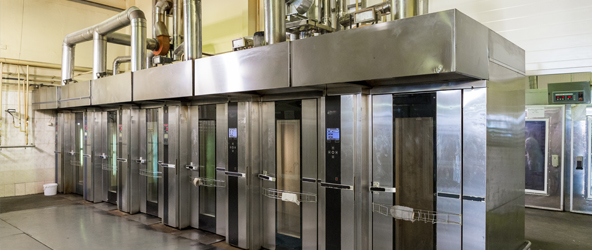

Heat recovery in the commercial baking industry involves capturing the excess heat generated by baking ovens, particularly tunnel ovens, and repurposing it for other uses.
Typically, a large portion of the energy used in these ovens escapes into the environment as waste heat. Heat recovery systems intervene by harnessing this energy, thereby improving overall efficiency and reducing waste.
Heat recovery in commercial baking is a three-step process designed to capture and repurpose waste heat from ovens, turning a potential loss into a valuable resource.
Heat recovery in the commercial baking industry primarily falls into two broad categories – air-to-air and air-to-water systems.
These systems focus on capturing heat from the oven’s exhaust air and using it to heat incoming fresh air. This is particularly useful in maintaining ambient temperatures in a bakery or replacing the exhaust with pre-heated make-up air.
These systems involve the transfer of heat from exhaust air or steam to water, which can then be used for various purposes in the bakery.
Depending on the specific needs and layout of a bakery, customized hybrid systems combining elements of both air-to-air and water-to-water recovery can be designed. These tailored solutions can meet specific operational requirements.
Integrating heat recovery systems into bakery operations is a smart business strategy. From slashing energy bills to baking better products and appealing to eco-conscious customers – it's a win-win-win situation.

Energy Efficiency
The most direct advantage is a substantial boost in energy efficiency. By capturing and reusing the heat that would otherwise be lost, bakeries can dramatically reduce the amount of energy they need to operate. This streamlines energy use so that every kilowatt hour does more for the business.
Environmental Sustainability
When bakeries reduce their energy use, they're actively cutting down on greenhouse gas emissions. This move towards more sustainable operations isn't just a win for the environment – it also strikes a chord with consumers who value eco-friendly practices.
Plus, by embracing these greener methods, bakeries can stay ahead of the curve with environmental regulations, sidestepping potential fines and setting a standard for responsible business practices.
Cost Savings
Investing in a heat recovery system might seem like a significant investment upfront, but the financial upside in the long run is pretty compelling. By reducing energy costs, these systems often pay for themselves over time. For forward-thinking bakeries, it's a smart move – especially with energy prices on the rise.
Enhanced Process Control
This benefit is often overlooked but is key in this industry. Heat recovery systems can offer more consistent and controlled heating or drying conditions which can lead to a noticeable improvement in product quality – think perfectly baked goods every time. This level of control can also help in reducing product wastage due to uneven baking.
While the adoption of heat recovery systems in commercial baking presents clear benefits, bakeries may still have concerns about practical and technical challenges.

The installation of heat recovery systems involves a significant level of technical complexity. The real trick is in integrating these systems flawlessly, preferably while the ovens are already in use. It's about finding that sweet spot where the system effectively recaptures heat without meddling with the oven's core functions or the baking process itself. This requires a nuanced understanding of both the existing oven technology and the intricacies of heat recovery systems, making it essential to involve experts who can tailor the installation to meet specific bakery needs.
A major consideration for bakeries eyeing heat recovery systems is the initial financial outlay. It's not just about affording the setup – there's also the task of calculating the return on investment (ROI). This calculation is unique to each business as it depends on the bakery's size, the fluctuating energy market, and the specific efficiency of the installed system.
Like any other piece of equipment, heat recovery systems demand consistent upkeep to perform optimally, which brings us to a significant concern for bakeries – the risk of downtime. Regular maintenance tasks like cleaning, component checks, and troubleshooting are necessary but can interrupt the continuous flow of a bustling bakery. For bakeries, where time is literally money and production schedules are tight, even a small amount of downtime can lead to significant losses and disrupt order fulfillment. This concern puts a spotlight on the heat recovery equipment and the need for a maintenance plan that minimizes disruption.
Many commercial bakeries operate in limited space, making the integration of additional equipment challenging. Heat recovery systems, depending on their design and the size of the bakery, can require significant space, which might not be readily available. Some heat recovery systems offer flexibility in terms of location and can be installed indoors or outdoors on a roof, next to a building, or where space is less tight.
Consistency is king in the baking world. The introduction of a heat recovery system must not upset the delicate balance of temperature and humidity that's essential for perfect baking results. This means the system needs to be finely tuned and monitored closely to maintain a stable environment inside the oven. Any deviation could lead to inconsistencies in product quality, which is a major concern for bakeries that pride themselves on the uniform excellence of their products.
As with any major equipment installation in a food production facility, bakeries must ensure that their heat recovery systems comply with all relevant health, safety, and environmental regulations. Navigating these regulations and ensuring compliance can be complex and time-consuming.
Bakeries use a wide range of ovens, each with its own set of characteristics. A heat recovery system suitable for one type of oven might not be as effective or even feasible for another. Tailoring these systems to work effectively across the spectrum – from the compact convection ovens of a small patisserie to the massive tunnel ovens of a commercial bakery – requires both ingenuity and technical finesse.
Heat recovery systems have made waves in the baking world – turning the heat efficiency game on its head for tunnel ovens. By snagging and reusing heat that would typically just vanish, bakeries are seeing real drops in both their carbon emissions and energy bills. However, downtime, investment costs, and integration difficulties remain a concern for bakeries.

The RHX Roof-Top Heat Exchanger System from ENERVEX provides a solution to these concerns while harnessing the full potential of heat recovery.
If you’d like to discover the power of the RHX Roof-Top Heat Exchanger System from ENERVEX – Contact us today to learn more!